Timeframe of the Persian Navy
The Persian Empire created by the Achaemenids (Cyrus the Great, 550 BC) was a landmass with few accesses at first to the sea. Only its maximum extension under the rule of Darius I (522 BC to 486 BC), so the Empire reaching the Caspian sea, encompassing the black sea, the red sea and part of the Indian ocean, but also the eastern Mediterranean.
This huge coastal area was controlled by various civilizations that actually did have maritime traditions, like the Phoenicians and Egyptians, lending their fleet and crews in Persian operations.
Later on, under the Parthian rule, and a long Hellenistic era, “Persia” was again mostly a landlocked entity with riverine areas nearby Iraq and the Persian Gulf. Under the Sassanid rule, it controlled some eastern areas but not the Black sea of the Mediterranean, both were controlled by the Roman Empire.
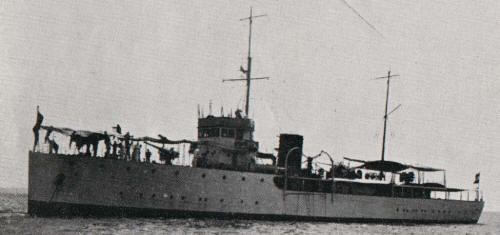
Babr, Persian Navy Sloop in 1941
Iranian ships articles
- Destroyer Artemiz (1965)
- Bayandor class FFs (1963)
- Alvand class FFs (1969)
- Khalije Fars class DDs (2016)*
The Persian Navy in WW1
At the eve of WW1 the Persian Empire comprised only a token fleet, comprising the 1885 Persepolis, a 1200 tons “gunvessel” iron-hulled ships, mixed (rigging and steam), with a ram bow, one funnel and a three-island hull and built at Bremen in Germany, discarded circa 1925. A small river vessel, Susa added on, also from the same AG weser yard of Bremen, and based a Mohammera in the Tigris-Euphrates delta. Both were manned by German crews but maintenance soon proved a problem, and both ships ended without their crews and their machines in total disrepair, moored permanently.
The latter Susa in 1906 was still reported armed with a 4-in BL gun, two 30 pdr also breech-loading guns (BL), and two light revolver guns. There was also the gunboat Muzaffer, a 1899, 400 tons ship and the Royal Yacht Selika brought in 1902.
Muzaffer actually saw service with the British Navy in WW1, was reconditioned at Bombay yard and returned to Persia, being stricken in 1936. Also in use was the customs steamer Azerbaidjan, based at Muscat, from 1918 in used with the Royal Indian Marine and returned in 1919, and the armed steamer Perebnoia, seized in 1920 by the Soviets at Enzeli on the Caspian sea, fate unknown.
Politics of the interwar
This was during the Qajar dynasty era (until 1925). After the great famine of 1871 there was a period of gradual reforms, culminating with the King granting a limited constitution in 1906. The Country was no longer an absolute monarchy. Discovery of petroleum by the British in 1908 also set new relationships with the British Empire, but also Russia, which ended in the Anglo-Russian Convention of 1907.
After a failed British attempt to create a protectorate, the Constitutionalist movement of Gilan actually ended the Qajar rule and the Palhavi house raised to power, through a military coup by a Persian Cossack. Rezha Khan introduced many reforms but set up in place an authoritarian government that valued law and order, nationalism, militarism, secularism and anti-communism.
There was deep resentment in the population over excessive “westernization” in a repressive police state. After a German influence attempt and British-Soviet invasion, the Tehran Declaration of 1943 guaranteed a postwar independance to Iran. However with Soviet backing both the Azerbaijan People’s Government and the Republic of Kurdistan were created in 1945 but did not last long.
The Persian Navy during WW2
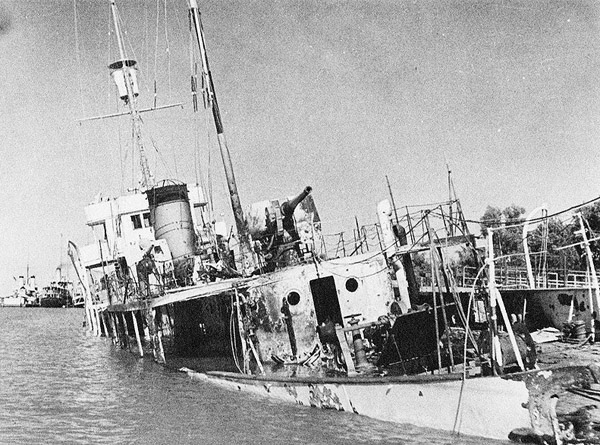
Sunken sloop Babr on 25 August 1941at Khorramshar
In 1922 Persia purchased the German minesweeper FM24 of 1918, 170 tons, renamed Fatiya and later Palhavi in 1926, then Shahan in 1935, discarded in the 1940s. Two sloops, four MTB and six motor gunboats were purchased from Italian yards, the Royal Yacht Chahsever in 1936, and the tug Neyrou.
The Azerbaidjan class patrol motor launches were 30 tons, 2088 x 3.81 x 1.07m boats propelled by two Krupp diesels of 300 hp. The class also comprised the Gehlani, Mazendern, Babolsar, Gorgan, Sef Indreude, all from CNR Palermo, and all discarded in 1935. The Babr class sloops were 950 tons ships, 63 x 9 x 3 m, propelled by two Fiat diesels rated for 1200 hp total and a top speed of 15 knots, with 120 tons of oil in reserve.
Also from the same yard, launched in 1931, they were armed with three 102mm guns and two MGs. The four Charogh class motor boats were 331 tons, 52 x 6.7 x 1.83m ships equipped with two Fiat diesels rated for 900 hp, top speed 15.5 knots and armed with two 75 mm and two 37mm dual purpose QF guns. All were launched in 1931.
The fate of Persia mirrored the fate of its fleet: First there was a German influence phase in 1940-41, both for strategic reasons (with both the Afrika Korps and Herresgruppe Sud in Russia advancing steadily) and of course the rich petroleum deposits, vital for the british Empire. In addition to an increase of German “tourists”, Axis ships also regularly visited Persian ports.
However to prevent the Empire to fall in the Axis sphere of influence, a double attack was launched in August 1941 by elements of the Red Army from the north and British Army from the south.
The small Persian army was quickly routed and brushed aside, and during the following weeks the fleet was either sunk or captured: Three Azerbaidjan class boats, the two Babr sloops, were sunk while the four Charogh were captured and incorporated into the RIN, rearmed by modern AA and returned in 1946, reverted to their original names.
The Iranian Navy during the cold war
Palavhi’s era
From these humble beginnings, cold war Iran emerged, still as a regional power with important assets and a strategic position, more so, being in the souther sphere of influence of the now hegemonic and seemingly unstoppable USSR, from the NATO point of view. Gradually Iran experienced an economic growth thanks to internal reforms and American help, especially during the latter Palhavi’s reign period. History of modern Iran could be resumed in several phases:
1- The early constitutional monarchy, under Reza Shah Palhavi rule, and a more powerful but unstable Parliament.
2- The setup of the Senate of Iran in 1949 and Prime Minister Mohammed Mosaddeq nationalizations campaign from 1951
3- BP concerns and UK-US intervention: The failed military coup of Colonel Nematollah Nassiri, and 1953 overthrown of Mosaddeq by allied agents of the CIA and MI6.
4- Return of an autocratic regime from 1952, backed by the US from 1961 and a set of reforms introduced
5- 1970s Public discontent, especially from the Clergy and traditionalist population, fierce repression, and degradation of relations with Iraq over the bordering Shat-El-Arab waterways.
6- 1979: Return of the Ayatholla Khomeini from exile, and Revolution: The Shah is exiled
7- Iran became an Islamic Republic, with a public officers purge and deep army reforms (and Navy)
8- Iran-Iraq war
9- New reforms and modern Iranian Navy
Creation of the Iranian Islamic Republic of Iran Navy
The Shah’s Navy
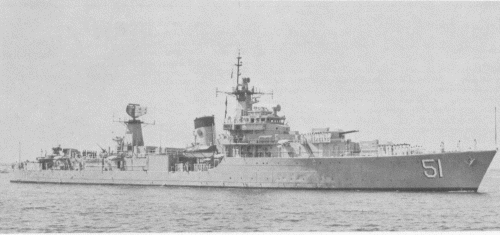
Iranian DD Artemiz (A battle class destroyer – src navypedia)
The previous regime received a considerable help allowing to acquire a sizeable Navy, related to the maritime area to cover. These were in 1975 three destroyers, nine frigates, two LSTs, three landing ships, 15 assault and hovercrafts by the time of the iran-Iraq war (This was the largest fleet of operational Hovercrafts worldwide). As well as many other lighter ships and boats. Major acquisiton was the Destroyer Artemiz (after Xerxes’s Admiral Artemisia), which was a late 1940s British “Battle” class (HMS Sluys) acquired in 1965 (more on this below, see details).
The fleet also inherited three 1930s Patrol Crafts and three Motors Launches. But the Shah’s navy also acquired two ww2-era Allen M. Sumner destroyers (in 1971) Babr and Palang, a single Loch class Frigate Babr (ex. Loch Assynt, acquired 1949 but paid off and stricker in 1972), and four Bayandor class Frigates (US PF 103 class), transferred under the Mutual Assistance Programme (MAP) from 1965 and 1969-70 after their completion. But foremost, the Samm class frigates, built by Vosper Thornycroft, Barrow and Newcastle yards, four modern ships launched 1968-69. One was sunk during the Iran-Iraq war in 1988.
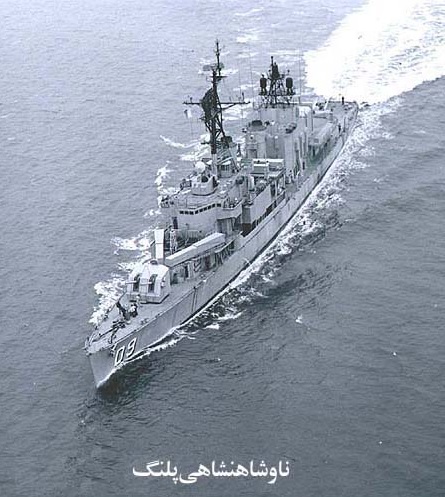
IIS Palang, Iranian DD of the Sumner class, thoroughly modernized in the US, and showing the Standard missile launchers. src iinavy.org. via wwiiafterwwii.
Supplies were British (most ships and hovercrafts), American (Many Transfers, especially in later period) and French (former LSIL and LCU, Kaman class FACs. With conflict looming with Iraq, transfer plans, especially from the US became more extensive and many orders were placed. Probably the most outstanding ones were the Kouroush class AA destroyers.
These were in essence four Spruance class missile destroyers initially ordered in 1974 as modified version tailored for Iranian needs, six ships originally but two were cancelled in 1976 and the four others started at Ingalls in April 1978, to be cancelled in February 1979 because of the Revolution.
These became the Kidd class in the USN. These would have been the only Spruance-class ever sold to a foreign country and a formidable addition to the Navy, if delivered.
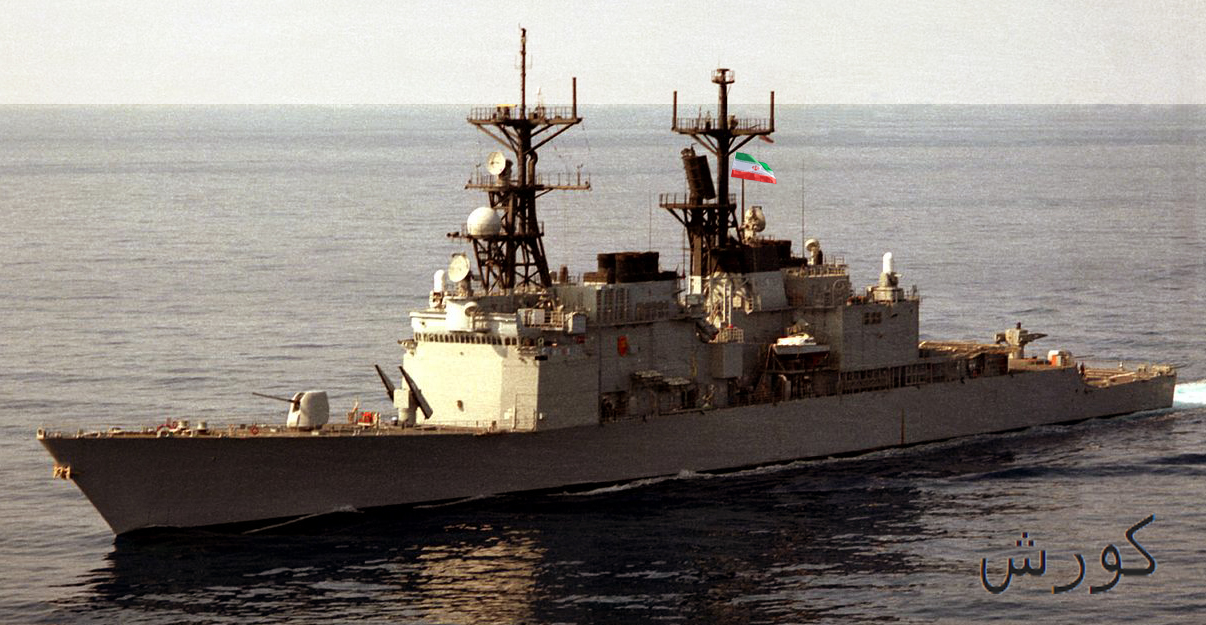
Rendition of the Kourosh class DDs (1979). These would have been the most formidable ships in the Persian Gulf and the whole middle east area if transferred in the early 1980s. All four were incorporated in the USN as the Kidd class, and transferred to Taiwan eventually in 2005-2006.
Other cancelled orders includes four Bremen-built NATO frigates (probably of the standard MEKO design, type 122), and six Kortenaer-class, 3500-3800 tons with CODOG, armed with 42 Harpoon SSMs and Mk.13 launcher, Sea Sparrow, one 127 mm gun and Vulkan-Phalanx CIWS and ASW torpedoes, plus two ASW helicopters (not precised at this point).
These were unnammed in 1978 when the order was passed, all intended to serve in the Persian gulf. For submarines, the first ones would have been West-German type 29 units (six, in 1978), three Tang Class (1951) cancelled en route, in UK in 1979. Submarines did take a hold in Iranian naval policy, but under the new regime.
In addition to the Hengam and Larak landing ships (ex French, ex-US LSIS) transferred in 1957-58 and Queshm LCU (1964), the Shah’s fleet was to be bolstered by six Iran Ajr LSTs built in Japan (acquired in 1980 and used as minelayers by the new navy) and four British-built (Yarrow, Clyde yard) Hengam class LSTs (only two delivered before 1979, two more cancelled in 1979 but released later in 1985 and unarmed “hospital ships”.
Interesting also were the 14 British-built Hovercrafts of the Wellington and Winchester types delivered before the revolution, for coastal defence and logistic duties. They were perfectly suited to the wide marshy wetlands of the Shat-al-Arab.
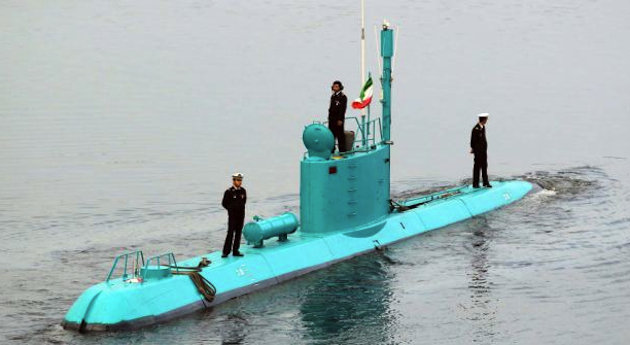
Iranian Ghadir class midget submarine (Times of Israel).
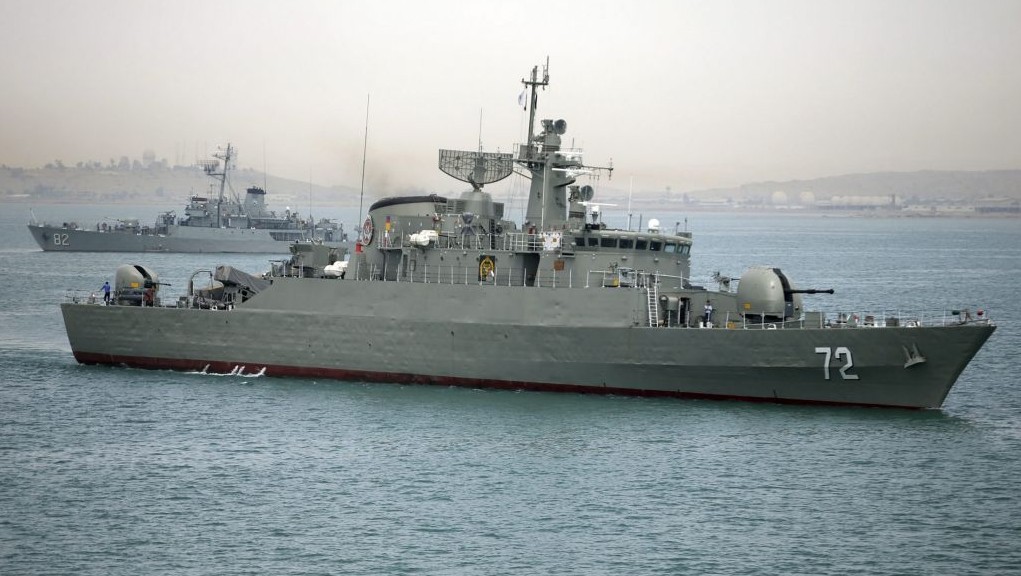
Iranian missile Frigate Alborz, Alvand class Frigate (Times of Israel).
Day one for the new Islamic Republic Navy
Outside an officers purge, the Navy inherited a considerable fleet, well able to deal with any threats in the Persian Gulf, especially with tension raising with Sunnite Iraq. Most ships described above were still extant by 1995, and most participated in the Iran-Iraq war. When an US-led arms embargo was imposed on Iran before and during the the Iran–Iraq War, the Navy was no longer capable to maintain and equip its navy previously made with Western equipments.
The Iranian Government therefore seeked for other sources both for equipment and weaponry, logically on the opposite side: Soviet Union (and Russian today), China, and North Korea. It was visible in the replacement for example of old British missile systems like the Sea Cat by Soviet-built twin 23 mm AA guns, judged more reliable. But this also triggered a domestic armament industry which is now thriving, with a destroyer and two frigate classes on order plus many midget submarines tailored for the Persian gulf, in some cases reverse-engineering some equipments or acquiring for example Chinese missiles.
The Iran-Iraq war (1980-88)
One of the fiercest war in middle-eastern history and often overlooked in the west, with by then an Iraqi army backed by the West and direct confrontation in 1988 between the USN and the Iranian Navy.
The IRI Navy played a role in this war, with battles fought both with Iraq and the United States as stated above, which degraded its conventional naval assets.
Operation Morvarid was a combined Navy and Air Force strike against the Iraqi Navy and aviation on 28 November 1980, targeting radar stations at Al-Bakr and Khor-al-Amaya oil rigs. This was a successful attack, destroy both oil rigs and the bulk of the Iraqi Navy, with in addition heavy damage to Iraqi ports and airfields.
Operation Praying Mantis: On 18 April 1988, there was a famous clash with the U.S. Marines operating within Iranian territorial waters. They destroyed Iranian naval and intelligence facilities on two oil platforms in the Persian Gulf. Doing these operations that also had to sink defendng crafts, three speedboats but also an Iranian frigate, a fast attack gunboat, and another frigate. Most of it was a retaliation for an American warship hitting an Iranian mine in the Persian gulf. This put strong pressure on Iran to agree to a ceasefire with Iraq, eventually ending the long conflict.
However this operation and the one in 1987 (Operation Nimble Archer) was criticized in 2003 by the International Court of Justice. The institution ruled that it cannot be justified as measures necessary to protect the essential security interests of the USA, dismissing however Iran’s claim it was a violation of the 1955 Treaty of Amity between the two countries.

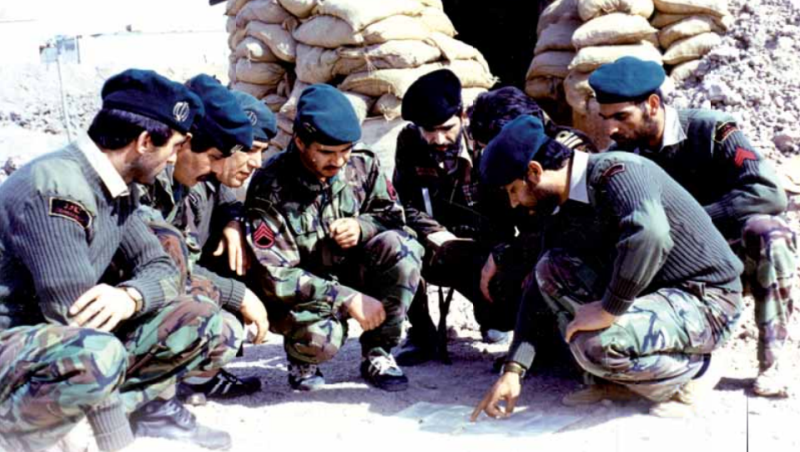
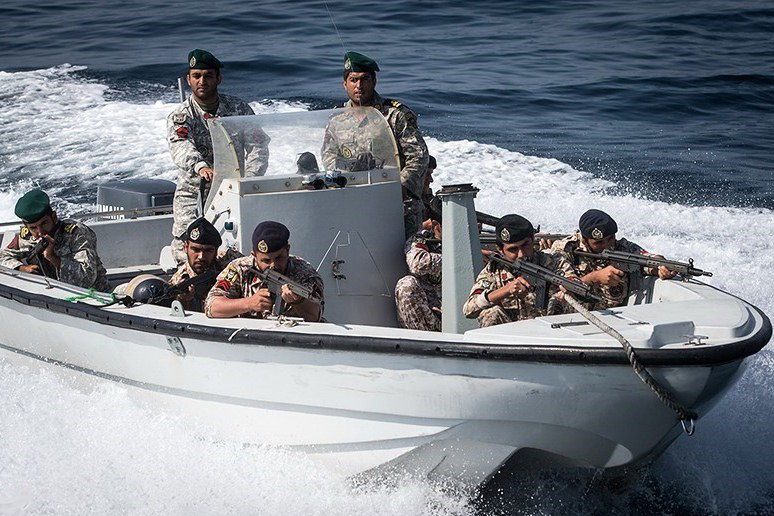
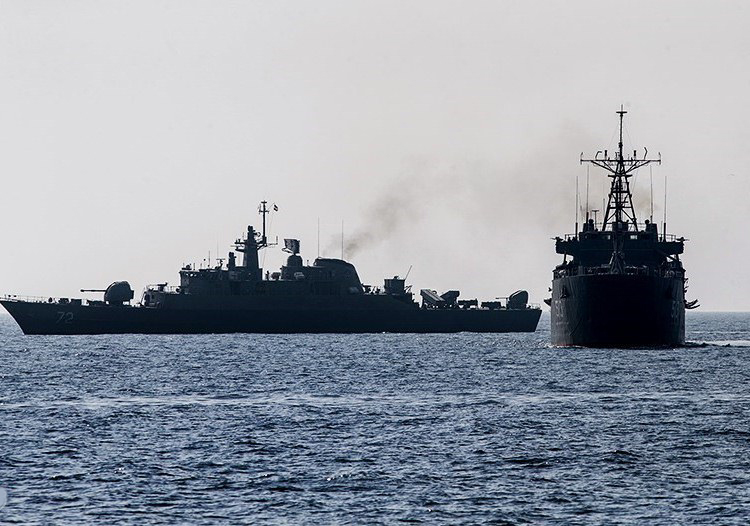
Above: Ships during the Velayat 94 naval exercises by Mbazri.
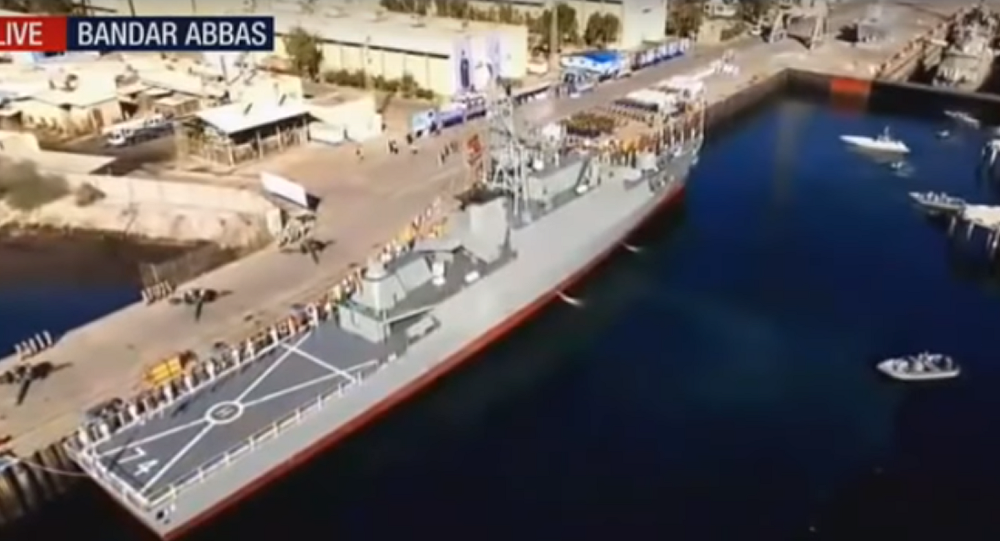
Video extract of the official ceremony – Iranian Sahand-class Frigate as of 2018 at Bandar Abbas.
Read More/Sources
ONI Iranian Navy, Posters of Leadership Structure and IRIN/IRGCN Recognition Guide 2009 (pdf)
FAS.org Iranian Navy – From Guerilla Warfare to a Modern Naval Strategy (pdf)
http://www.navypedia.org/ships/iran/iran_dd_artemiz.htm
https://en.wikipedia.org/wiki/Islamic_Republic_of_Iran_Navy
http://www.navypedia.org/ships/iran/iran_index.htm
https://en.wikipedia.org/wiki/List_of_current_ships_of_the_Islamic_Republic_of_Iran_Navy
http://www.sadra.ir/
http://www.hisutton.com/Iran_Submarine_forces.html
Nomenclature of the Iranian Navy
Destroyers
Davamand (ex-Artemiz, 1965)
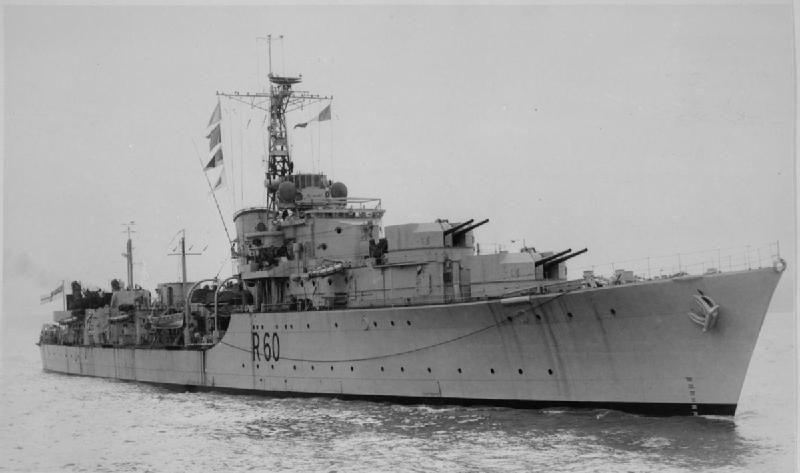
The original HMS Sluys (D60)
This Battle class destroyer, built in the early cold war on ww2 plans at Cammell Laird, was named HMS Sluys (D60). She was taken in hands in 1962 and completely rebuilt and modernized at Vosper Thornycroft to be transferred in 26.1.1965 to Iran, according to the Shah’s request. In 1965 she has been fitted with a new bridge, new radar, passive sonar and a new aerial was fitted on a rear mast, aft of the funnel. Armament was only kept forward, the same original twin turrets, 114 mm dual purpose QF Mark.IV in semi-automated mountings;
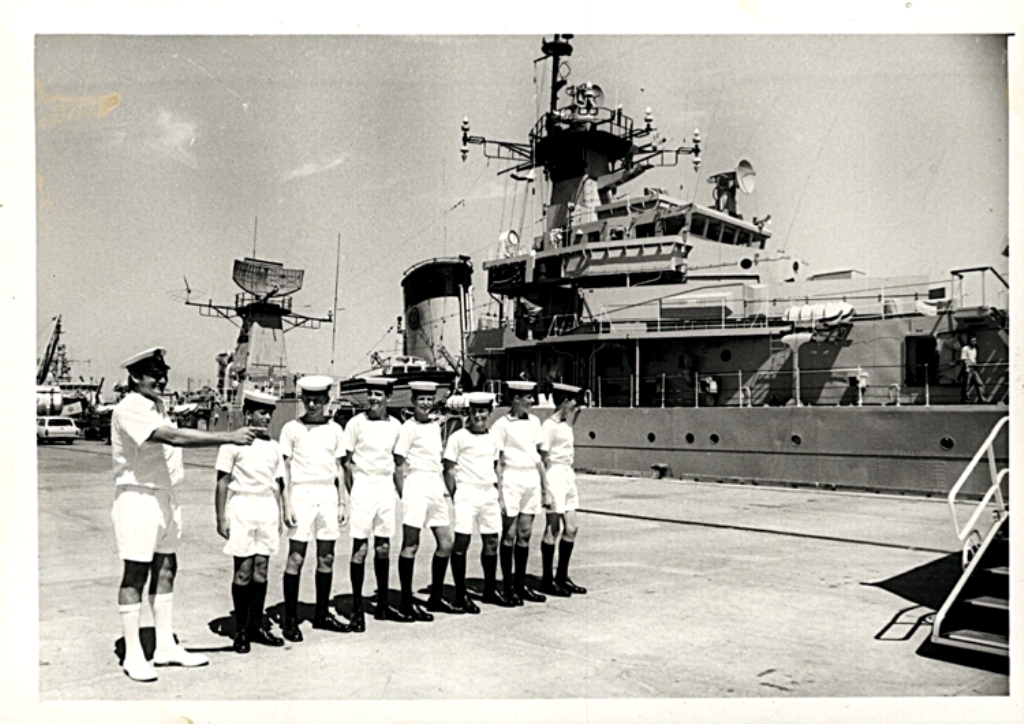
The rear turret was sacrificed to make room for a triple Squid ASW mortar at the stern while a seacat SAM launcher was installed on the superstructure. In addition she had four single 40 mm/60 Bofors installed either side in positions beneath the rear aerial radar mast and of the funnel. Some records says she was armed with twin mounts, therefore eight 40 mm/60 Bofors in the early 1970s.
She underwent a major refit in South Africa in 1975-76 where she received four standard SSM launchers, for eight anti-ship missiles standard, and AA was reduced to the two 40 mm aft. She received a Plessey AWS-1 surveilance radar and IFF, plus two Contraves Sea Hunter fire control radars, a Plessey MS-26 sonar and a DECCA RDL-1 ESM suite.
In 1985 Artemiz was renamed Davamand, a more fitting name after the revolution. She had her Sea Cat system removed, and received two 23mm/80 AA guns (Soviet built) instead. By the time she was frequently spotted at sea during the Iran-Iraq war she was credited for a speed of 23 knots; Extant in 1990, inactive but still listed in the mid-1990s she was broken up as a new frigate took her name, of the Moudge class, since lost in the Caspian sea in 2018. Src She has been replaced since by the current 7000 tons Khalije Fars-class destroyer, first Iranian-built destroyer in 2013, undercover of a training vessel.

Conway’s rendition of the Artemiz in 1975
Babr class destroyers (1971)
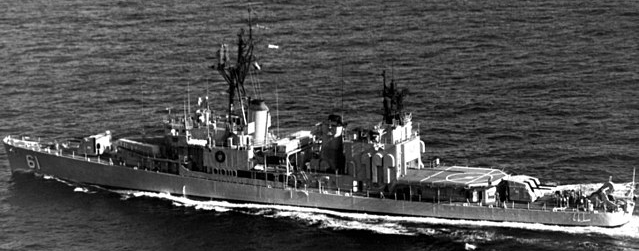
Babr (‘Tiger’) and Palang (‘Leopard’) were the former Allen M. Sumner Zellars and Stormes from Todd Pacific Yard. They had been already converted in the FRAM II standard. However both differed in their FRAM arrangements: Babr for example ha its main deckhouse widened during a refit as far forward as admidships but half as long as on Palang.
In 1974 the government choosed them to be sold to Iran, and they were sent for a refit in Philadelphia Nyd: The air conditioning was modernized and improved, the old 100 KW generators were replaced by new 500 KW units, the B-turret was removed along with its magazine, replaced by storage rooms. Also accommodations were altered, and a Knox-class helicopter hangar, of the Canadian foldable model was installed to house an AB-204 ASW helicopter.
Four universal launchers (for eight SSM missiles but usable to fire SAMs as well) were situated on a platform between stacks. VDS was installed on the first level deck, forward of the bridge, and two Hedgehogs on B position. Babr also diverged by having SQS-43 sonar including a SQS-31B hull-mounted sonar and SQA-10 VDS. Palang had its own VDS removed for spares, to Babr. New torpedo storage was also fitted between the funnels. The landing platform was widened out to the ship’s sides and the old hangar removed.

Rendition of the Babr class destroyers
Babr also had the small ECM house and mast atop the hangar while palang had a large one and its house was transferred to Babr, further advanced and due to completion first. A new house and masts were later built for Palang, accentuating the differences between the two ships. In the end, this updated panoply made both ships far more advance than usual FRAM USN conversions. Two more ships of the class, DD713 and 881 (USS Kenneth D Bailey and Bordelon of the Gearing class were purchased in 1975 and 1977 for spares.
After some service with the Iranian Navy, both ships had their old VDS and Hedgehogs removed and a twin 23mm/80 AA Soviet gun was installed in place of the VDS. In 1992, apparently the second digit of their pennant number ID was painted to forbid identification. As a note, the Iranian Navy already operated a frigate name Babr, from 1949 to 1972 when she was stricken. This was the ex-Derby Haven, a Loch class Frigate called originally Loch Assynt, acquired in July 1949 but only used as depot ships for landing crafts. She was paid off in 1969.
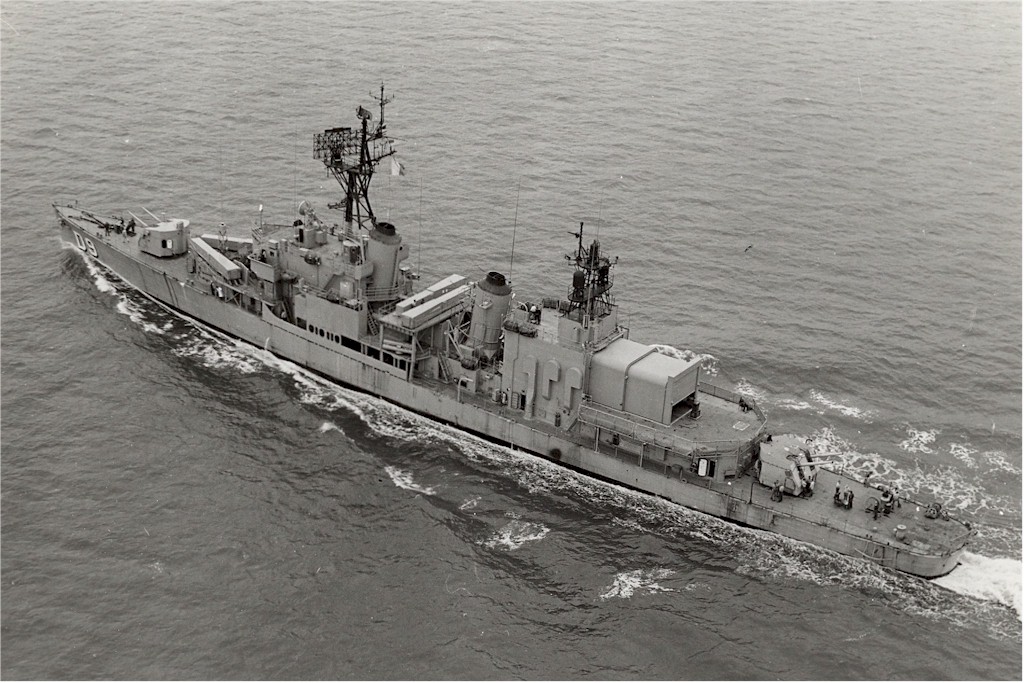
IIS Palang – credits navsource.org >
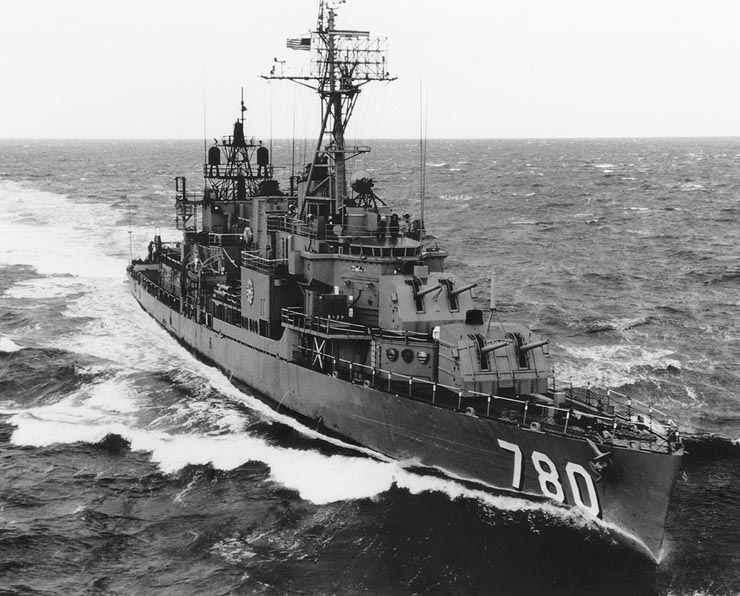
USS Stormes DD-780 off Hampton Roads in 1968, before modernization and transfer.
Frigates
Bayandor class Frigates (1963)
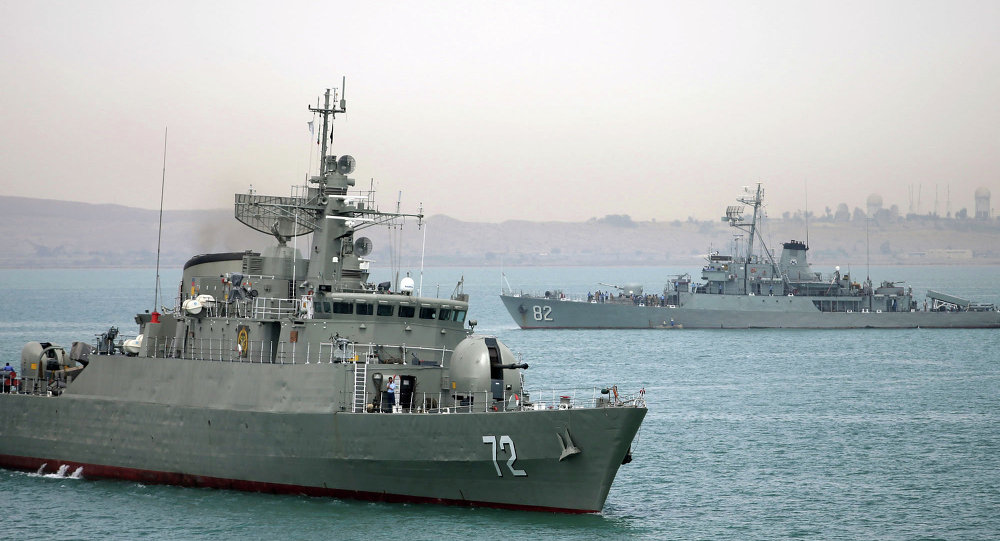
A Bayandor class in the background, deployed on the black sea during an exercise – credits sputniknews.org
These ships were of the PF 103 class Frigates, built in two batches at Levingston SB, Texas they were orignally laid down in 1967, as PF 103, 104, 105 and 106, but renamed for MAP transfer (Mutual Assistance Program), and received in 1968-69 as Bayandor, Naghdi, Milanian and Kahnamuie (all officers killed during the 1941 invasion or Iran). They were derived, and closely based on the Indonesian Pattimura class built by an Italian yard, also on US funds provided under MAP. Note these ships were reclassified as Corvettes in the 1980s.
Their specifications were changed (see specs) but originally both ships had two 76 mm/50 DP guns Mk.34, two 40 mm AA guns, one hedgehog and four DCT, plus two DC racks and 60 deep charges in all. So basically they were specialized ASW vessels, but all this ws deposed during the Iran-raq war. Their electronic suite comprised the SPS-6 radar by Raytheon, SPG-34 and SQS-17 Sonar and for complement between 113 and 140 officers and sailors.
In 1988 Naghdi was reconstructed, accomodations and main engines replaced. Their Iranian 23 mm AA guns were replaced by two 20 mm Oerlikon guns GAM BO1 in 1990. Milanian and Khnamuie were sunk during the war with Iraq in 1982. The two others were still in service by 1995 but scrapped in the 2000s.
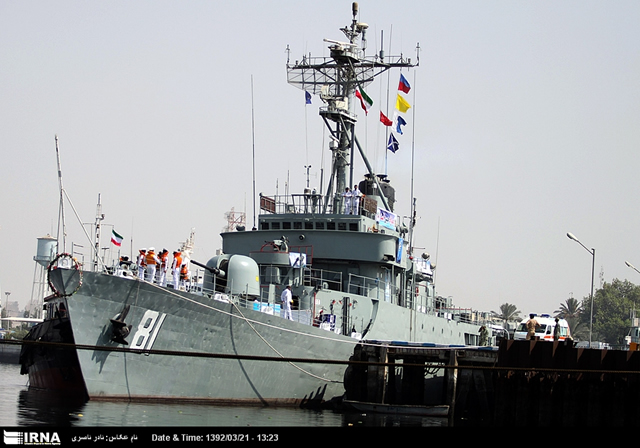
Bayandor class Corvettes – IRNA archives 21/03/1392 on the Islamic calendar, if well red it would be 1971.
On 11 June 2013, Bayandor emerged from a a 20-month refit and overhaul: The main engines were overhauled as well as heat converters and fuel systems. Monitoring systems were also upgraded and a new fire control system and radar were installed. A Fajr-27 76 mm dual purpose Oto Melara RF cannon was installed at the front and reinforced by a twin 40 mm AA in addition to two twin Noor AS missile launchers SSMs.
Specifications (1985)
Displacement: 9000/1135 tons standard/Fully loaded
Dimensions: 83.8 x 10 x 3 m
Machinery: two shaft Fairbanks-Morse 38D81/8 diesels 6000 hp and 20 knots, oil 110 tons range 3000 nm
Armament (as revised): 2x 76 mm, 2×2 23 mm AA, 2 DC racks
SAAM (Alvand) class Frigates

In 1966 Vosper Ltd at Portsmouth received an order for four “destroyers” which were modelled on the Vosper Frigate, a considerable export success. Indeed engineers, working with Iranian specifications came to the conclusion a Frigate cold carry a much more powerful, yet still light and manageable armament, coupled with a much more powerful yet compact powerplant.
On this latter part, British engineers found a way to cram into such limited space powerful yet compact Olympus marine gas turbines which were rated for 22.500 hp, becoming the main source of power instead of the traditional “booster” coupled with conventional steam turbines.
Also diesels could be added for cruising making a perfect CODOG combination. An acronym that was epoch-making and soon imitated by many other shipyards for military grade vessels. As a reminder, previous turbines were rated for 7500 shp at best. This was triple the power. Gearing was simplified thanks to the new combined arrangement. In addition, more powerful and automated armament, combined with the reliable and easy maintenance required for CODOG allowed to lower the crew and to crown it all, the Vosper design called for added modularity, not only for the engines, but also for the electronics compartments, making upgrades or taylorisation easier.
It was known as the Mark 5 “destroyer” project until receiving official Persian names: Saam, Zaal, Rostam and Faramaz. The first and last were launched at Vosper Thornycroft in 25 and 30 July 1968-69 and the two others at Vickers, Barrow and Newcastle respectively on 4.3.1969.

Ships of the classs at the 1994 Velayat naval exercize, by Mbazri
These ships, privately funded by the yards and researched, were 2/3 cheaper than equivalents using usual methods based on official requirements. Vosper engineers lowered the quality standards a bit, and part of this came through a revision of official specs for near-miss shock resistance, and engines assembly. In theory the ships were noiser, but compensated by their greater speed and agility.
In addition to KaMeWa CP propellers they had also retractable Vosper stability fins and high grade air conditioning. Saam and Zaal returned to HM Devonport yard during the summer of 1975 for a refit completed in May 1977. They received a Mk 8 114 mm gun, retractable hull sonar, computerized electronic room for central operations of armaments and detection, and a similar control room was created to manage the engines.
After the Islamic revolution, the ships were renamed in 1985 Alvand, Alborz, Sabalan and Sahand, islamic figures or symbols whereas the previous names were based on a classic Persian epic. One of these ships was sunk in th persian gulf by the US Navy in April 1988, Sahand, by a combined attack from USS Joseph Strauss (three harpoons hits) and cluster bombs from USS Enterprise planes. Sabalan was badly damaged too loosing her back due to a smart bomb. However she was towed to safety and repaired, returning into service in 1991.
Still in 1988, the Iranian admiralty decided to get rid of the British Sea Cat system and installed instead a Soviet-built twin 23 mm/80 and later, still on the three ships, three 20 mm Oerlikon GAM BO1 guns instead in 1990. The remaining three ships are still active in today under the name of Alvand class.
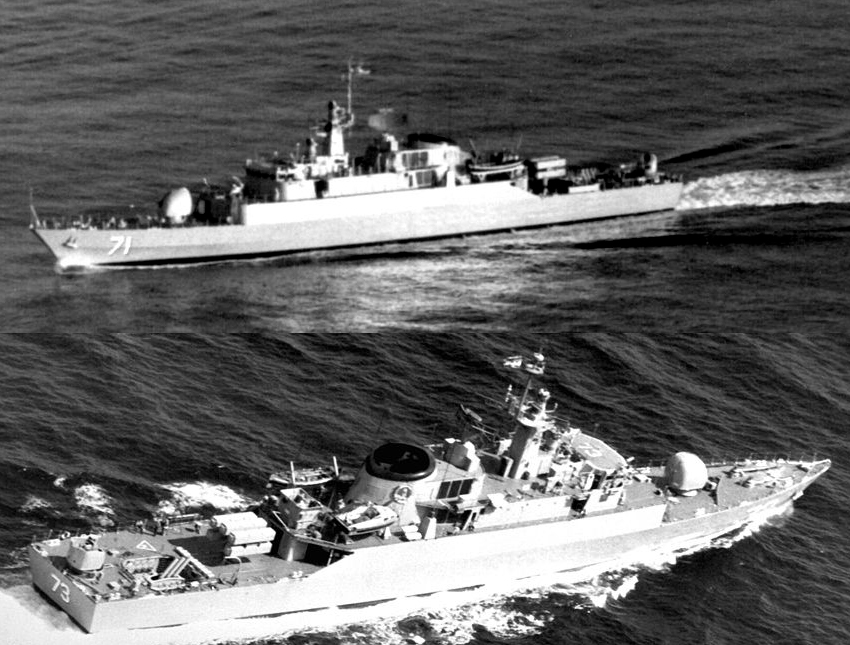
IS Sabalan and Alvand in the 1980s (Persian Gulf)
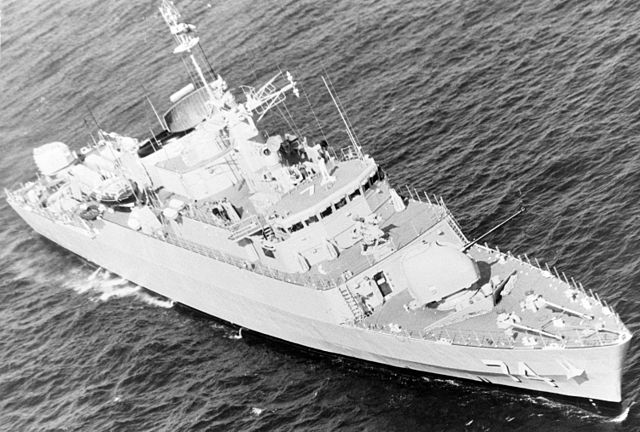
IS Sahand in 1977
Specifications (as of today)
Displacement: 1250/1545 tons standard/Fully loaded
Dimensions: 94.5 x 10.5 x 3.5 m
Machinery: two CODOGs Rolls Royce Olympus TM3A (46,000 hp and 40 knots)
2 Maxman 16 cyl. Ventura diesels (3,800 hp and 17.5 knots) – 250 tons of oil, range 5000 nm
Armament (as revised): 1 Sea Killer Mk2 SSM, 1x 114 mm/45 DP, 2x 35mm/90 Oerlikon-Bührle GDM-A, Limbo Mk10 ASW mortar, 3x 20 mm Oerlikon AA.
NATO standard unnamed Missile Frigates (1979)

Six standard NATO frigates to be built, four by Bremer-Vulkan and eight more at Rhine Schelde Verolme in Holland. They would have been a mix between the Kortenaer and German Type 122 Frigates. Iran specified in 1978 than it should be the same as NATO Frigates, for full compatibility with US systems and integration within a USN-led task force in the region. This was also in orer to reduce costs, training and maintenance. The hull was a copy of the Kortenaer, and propulsion came from the Type 122 (Bremen class).
However most alteration were tailored for the Persian gulf, with air conditioning anf facilities, but also operational requirements, extended radius of action, out of range of air cover and far from operational bases. They were to carry an extensive AA armament (127 mm/54 DP Mk45, 2×6 Vulcan-Phalanx Mk15 CIWS, SM1-MR launcher assisted by two Mk86 Lockheed FCS, SPG-60, SPS-48C) and substantial EW system (The SLQ-32).
SSM were standard US Harpoon systems (42 in store) in a Mk13 Mod4 system. In alternative to the SM, a sea sparrow SAM Mk.29 was also studied in a modular fashion. ASW warfare relied on two twin 324 mm TTs for Mk46 torpedoes, and two helicopters SH60B LAMPS III or WG13 Sea Lynx/Puma. ESW electronic suite relied on a German bow sonar 80 set and VDS aft. These 3,000 tons standard ships were powered by a CODOG system and cruise diesels, 30 knots and 50,000 hp. In addition they carried a satcom, NTDS, Tacan, Navigational radar, chaff launchers, and Link 14, 11 and 4A.
The 1979 revolution doomed the contract, which was cancelled. But one can imaging what would had resemble an Iranian fleet comprising, in addition of the above, twelve standard NATO Frigates and six Spruance type destroyers in the 1980s.
Hamzeh class corvettes (1965)

This Imperial/government yacht Shahsavar was built in the Netherlands at Boele Yard, Bolnes. Launched in 1936 she first served as Hamzeh has been modified to carry C-802 anti-ship missiles and light defenses. It is currently part of the Iranian Navy Caspian Sea fleet of warships. She displaced 580 tons and was 54 x 7.65 x 3.25 meters in size, capable of 15 knots. In 1964 when she could have been discarded, she was taken in hands for modernization, and serve on the Caspian sea.
She was renamed Hamzeh, modified to carry C-802 anti-ship missiles and light defenses: Four C-802 anti-ship missiles completed by 1 x main gun (20 mm), 2 x 12.7 mm manned heavy machine guns. This corvette is still today in service, flagged as the “oldest ship in service in the middle east”.
Post-cold war additions
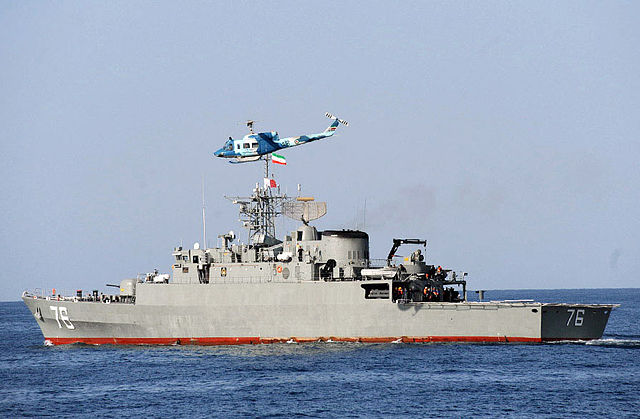
Frigate Jamaran (2010) – See the model presented by the C-in-C in a TV interview, Iranian TV: //www.youtube.com/watch?v=s6BQf6e9l-I
Khalije Fars (‘Persian Gulf’) class destroyers (2016)
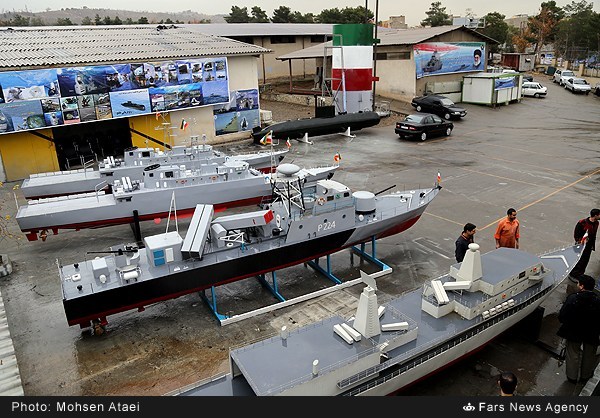
Showcase of four Iranian classes in constructions: The closest to us is likely the new Persian Gulf class, still bare at this stage and indeed relatively wide for a destroyer. (Credits Mohsen Ataei for FARS news agency)
A single ship, 7,500 tons fully loaded, 5000 standard as designed, 145 m x 16 m x 7 m and propelled by two 18 megawatts gas turbine engines, and two 4 megawatts diesel engines, plus six megawatt electric generators, to produce an overall speed about 30 knots (56 km/h; 35 mph) as designed for a planned autonomy of 8,000 nautical miles (15,000 km; 9,200 mi).
Each would be equipped by an Asr Radar as understood from the exhibited model and armed with an estimated combination of a RF 76 mm (3 in) DP auto-cannon, reverse engineered version of the OTO Melara, a CIWS (also Iranian made), eight Qader anti-ship missiles, two 20 mm Oerlikon cannons and two Anti-torpedo system, likely copies of the triple 324 mm ASW and Mark 45 torpedoes, and a hangar for a Bell helicopter.
This ship is a major undertaking for Iran to say the least. It has been planned by the Marine Industries Organization, with six on order. Technically this is a “training warship”, which does not tell really about the whole program, but a conventient and believable cover story. More: http://en.farsnews.com/newstext.aspx?nn=13920701000796
‘Moudge’/Moje class frigates (2010)
Jamaran, Davamand (2013), Dena (2017?), Moudge 4 (2015?), Sahand (2012), Moudge 6 and 7 in construction. They are domestically produced Iranian light frigates, likely a development of the Vosper-designed Alvand-class design in the 1970s. They were indeed quite similar but heavily armed with four Noor or Qader anti-ship missiles, a 76 mm Fajr-27 naval gun, 40 mm Fath-40 AAA, two 20 mm cannons Oerlikon, four Mehrab Missiles (SM-1 SAM copies) or Raad SAM Missiles, two triple 324 mm TTs and two 12.7 mm heavy machine guns.
Sahand class Frigates (2018)
https://www.youtube.com/watch?v=GePGUEaZkzQ
Service ceremony for IS Sahand, 2018.
A successor of the Jamaran (Moje/Moudge class), apparently launched in 2012 but completed only in 2018, and first estimates and official specs shows a 2,000 tons ship, 100 x 12 x 3.5 meters in size, propuled by two shafts diesels (four) rated for 70,000 hp ? for a top speed of 30 knots (56 km/h). They carries four C-803 (Ghader) anti-ship missiles, one 76 mm Fajr-27 naval gun (similar to the OTO Melara model), four Sayyad-2 SAM, a single 40 mm AAA, Kamand CIWS, and two triple 324 mm ASW torpedoes, plus two 12.7 mm machine guns.
They are much improved and larger, apparently with a hangar large enough to accomodate a single Sikorsky CH-53 Sea Stallion helicopter in alternative to two AB-212 helicopters. Currently in service for the Persian Gulf fleet from Bandar-Abbas. The name honoring the sunken frigate during Operation Praying Mantis on 18 April 1988. Others on order, details unknown.
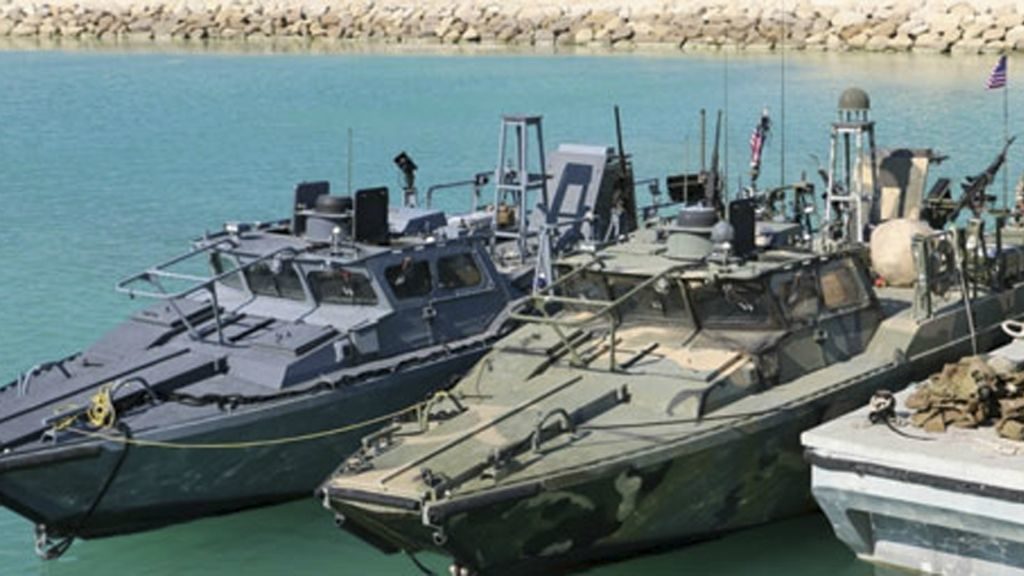
“This picture released by the Iranian Revolutionary Guard on January 13, 2016, shows detained US Navy sailors’ boats in custody of the guard in the Persian Gulf. (Sepahnews via AP)” (Via Times of Israel)
See also: Iranian Submarine force as of 2019 (Poster by HI Sutton)


 Latest Facebook Entry -
Latest Facebook Entry -  X(Tweeter) Naval Encyclopedia's deck archive
X(Tweeter) Naval Encyclopedia's deck archive Instagram (@navalencyc)
Instagram (@navalencyc)





 French Navy
French Navy Royal Navy
Royal Navy Russian Navy
Russian Navy Armada Espanola
Armada Espanola Austrian Navy
Austrian Navy K.u.K. Kriegsmarine
K.u.K. Kriegsmarine Dansk Marine
Dansk Marine Nautiko Hellenon
Nautiko Hellenon Koninklije Marine 1870
Koninklije Marine 1870 Marinha do Brasil
Marinha do Brasil Osmanlı Donanması
Osmanlı Donanması Marina Do Peru
Marina Do Peru Marinha do Portugal
Marinha do Portugal Regia Marina 1870
Regia Marina 1870 Nihhon Kaigun 1870
Nihhon Kaigun 1870 Preußische Marine 1870
Preußische Marine 1870 Russkiy Flot 1870
Russkiy Flot 1870 Svenska marinen
Svenska marinen Søværnet
Søværnet Union Navy
Union Navy Confederate Navy
Confederate Navy Armada de Argentina
Armada de Argentina Imperial Chinese Navy
Imperial Chinese Navy Marinha do Portugal
Marinha do Portugal Mexico
Mexico Kaiserliche Marine
Kaiserliche Marine 1898 US Navy
1898 US Navy Sovietskiy Flot
Sovietskiy Flot Royal Canadian Navy
Royal Canadian Navy Royal Australian Navy
Royal Australian Navy RNZN Fleet
RNZN Fleet Chinese Navy 1937
Chinese Navy 1937 Kriegsmarine
Kriegsmarine Chilean Navy
Chilean Navy Danish Navy
Danish Navy Finnish Navy
Finnish Navy Hellenic Navy
Hellenic Navy Polish Navy
Polish Navy Romanian Navy
Romanian Navy Turkish Navy
Turkish Navy Royal Yugoslav Navy
Royal Yugoslav Navy Royal Thai Navy
Royal Thai Navy Minor Navies
Minor Navies Albania
Albania Austria
Austria Belgium
Belgium Columbia
Columbia Costa Rica
Costa Rica Cuba
Cuba Czechoslovakia
Czechoslovakia Dominican Republic
Dominican Republic Haiti
Haiti Hungary
Hungary Honduras
Honduras Estonia
Estonia Iceland
Iceland Eire
Eire Equador
Equador Iran
Iran Iraq
Iraq Latvia
Latvia Liberia
Liberia Lithuania
Lithuania Mandchukuo
Mandchukuo Morocco
Morocco Nicaragua
Nicaragua Persia
Persia San Salvador
San Salvador Sarawak
Sarawak Uruguay
Uruguay Venezuela
Venezuela Zanzibar
Zanzibar Warsaw Pact Navies
Warsaw Pact Navies Bulgaria
Bulgaria Hungary
Hungary

 Bundesmarine
Bundesmarine Dutch Navy
Dutch Navy Hellenic Navy
Hellenic Navy Marina Militare
Marina Militare Yugoslav Navy
Yugoslav Navy Chinese Navy
Chinese Navy Indian Navy
Indian Navy Indonesian Navy
Indonesian Navy JMSDF
JMSDF North Korean Navy
North Korean Navy Pakistani Navy
Pakistani Navy Philippines Navy
Philippines Navy ROKN
ROKN Rep. of Singapore Navy
Rep. of Singapore Navy Taiwanese Navy
Taiwanese Navy IDF Navy
IDF Navy Saudi Navy
Saudi Navy Royal New Zealand Navy
Royal New Zealand Navy Egyptian Navy
Egyptian Navy South African Navy
South African Navy






























 Ukrainian Navy
Ukrainian Navy dbodesign
dbodesign